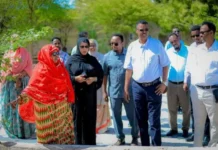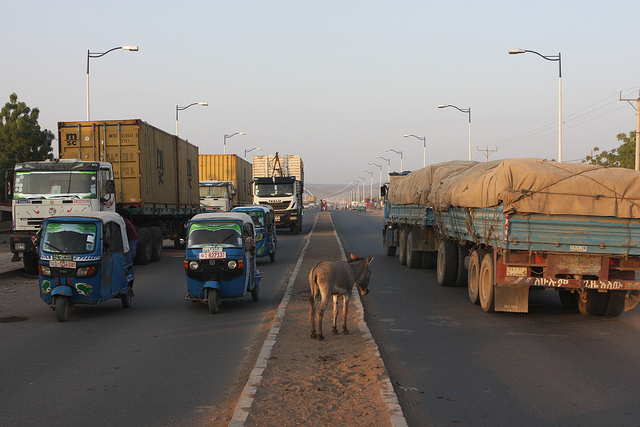Once made infamous through explorers’ tales of old, Ethiopia’s remote northeast Afar region both conforms to and contradicts stereotypes.

Tough neighbourhood: Ethiopia’s remote northeast Afar region contains the Danakil Depression—the hottest place on earth where temperatures in the naked plains frequently soar above 50 degrees centigrade, exacerbated by the fierce blowing of the Gara, which translates as Fire Wind. Such inhospitable conditions haven’t stopped the Afar, who regard themselves as the oldest of Ethiopia’s ethnic groups having occupied their arid homeland for at least 2,000 years. Credit: James Jeffrey/IPS

Armed but amiable—fortunately: Here a young Afar man unsheathes the sword he carries attached to his waist. Historically, the Afar menfolk gained a reputation for ferocity and intolerance of outsiders, including the habit of cutting off the testicles of any foreigner found in their territory. The reality now is far removed from the stereotypes of travellers’ tales—the majority of Afar that the author met proved friendly, as well as patient about his photographic requests. Credit: James Jeffrey/IPS

Less on the move nowadays: A kite bird of prey rests on a rooftop in the town of Asaita overlooking the Awash River, beside which can be seen distinctive dome-shaped Afar homes. Traditionally the Afar are nomadic pastoralists, living in light, flimsy houses which they transport from one location to the next on camel back. Recent decades have seen a trend towards an increased dependence on agriculture in the fertile and well-watered areas around the likes of Asaita. Credit: James Jeffrey/IPS

Pastoralist past not forgotten: Here a woman weaves palm frond into the matting used to cover traditional Afar homes. Afar women are typically responsible for constructing a family’s nomadic home from the ground up when a family moves to another location. Despite a visitor encountering friendliness, you still sense a robust mentality among the Afar, shaped by that tough nomadic pastoralist past, and which still continues, evidenced by the camels continuing to plod across the desert, and the clusters of domed houses dotting the parched plains. Credit: James Jeffrey/IPS

What’s that shimmering in the heat haze?: In the plains surrounding Asaita an enormous sugar factory towers over surrounding Afar homes, evidence that there appears to no longer be any part of Ethiopia immune to the country’s ambitions to develop. In recent years the government has made a concerted effort to establish sugar factories to meet growing local demand, create jobs and boost economic growth. This has included locating factories in remote areas instead of being concentrated in one region. Credit: James Jeffrey/IPS

Even the Afar can be shy: Here a young Afar woman consents to be photographed, though only after covering part of her face. Afar women often have intricate frizzed and braided hairstyles, and wear bright coloured bead necklaces, heavy earrings and brass anklets. Many Afar women cover their heads in public. This helps ward off the relentless sun. At the same time, the vast majority of Afar are Muslim. Despite Afar’s ancient trade links with the Christian highlands to the west, Islam was widely practiced in the region as early as the 13th century. Credit: James Jeffrey/IPS

Renowned for distinctive hairstyles: It’s not just Afar women who embrace eye-catching hairstyles. Afar men often wear their hair in thick Afro style or equally distinctive long curls, and dress in a light cotton toga. While these two men aren’t armed, Afar men rarely venture far without a sword or dagger, and these days the traditional knife can be supplemented or replaced by an AK-47 slung casually over the shoulder. Such weapons are still frequently put to fatal use in disputes between local clans. Credit: James Jeffrey/IPS

Trading salt and more: The main thoroughfare through the city of Logiya sees a constant stream of trucks on the way to and from ports across the nearby border in Djibouti. At the same time more modern goods are being taken into Ethiopia to sustain the growing needs of its developing population, the Afar continue to load up camels with bars of salt, cut out of the desiccated ground, to transport to the region of Tigray along the ancient caravan routes. Until modern times, the Afar region effectively served as Ethiopia’s Mint, producing the amoles—salt bars—that served as the main currency in the highlands. Credit: James Jeffrey/IPS

Beguiling mix: At Asaita the Awash River cuts a green swathe through the desert, evoking images of Egyptian pastures watered by the Nile. As the sun begins to set over Asaita, the muezzin can be heard calling the faithful to prayer, while electric lights start appearing in the sugar factory in the distance. It’s a striking impression of old and new, tradition and modernisation co-existing together. “Things are simpler here,” Yohannes, a young man in Logiya, says about the local way of life. Credit: James Jeffrey/IPS

Still embracing the low-tech way of life:
Despite Ethiopia undergoing great changes as it rapidly develops, the nomadic lifestyle lives on in Afar away from its urban centres. Afar men can be seen driving their precious camel herds alongside roads, or as small specks in the distance stretching out across the sands before finally disappearing in the hot horizon. Traveling around Ethiopia and the likes of the Afar can leave a visitor pondering what countries in the Global South might teach more developed countries rushing headlong into a high-tech-focused future about better balancing tradition and modernisation. Credit: James Jeffrey/IPS
IPS






































